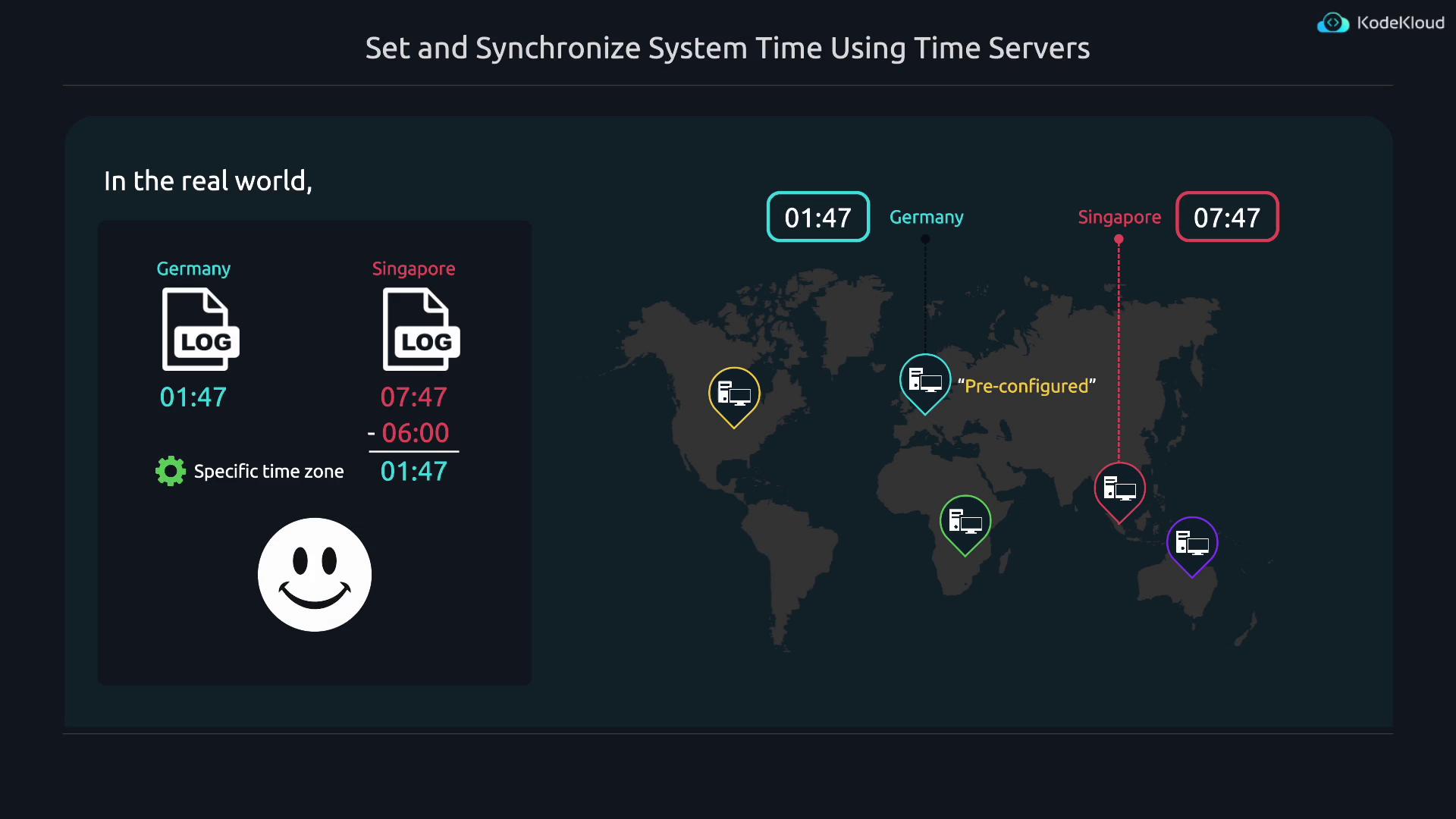Linux Foundation Certified System Administrator (LFCS)
Networking
Set and Synchronize System Time Using Time Servers
Accurate timekeeping is critical for server operations. Hardware clocks in computers are not perfect and may gradually drift from the actual time. For instance, if the real time is 12:00:05, a server might display 12:00:06—a one-second drift ahead. Fortunately, most devices today automatically synchronize their clocks over the Internet using the Network Time Protocol (NTP).
Most modern operating systems include time synchronization software by default. In Ubuntu, the default utility is systemd-timesyncd, which is part of the systemd suite.

Configure Time Zone Settings
In addition to time synchronization, it is important to correctly set the time zone. Incorrect time zones can lead to confusion, especially when managing logs from servers located in different regions. For example, when it is 1:47 in Germany, it is 7:47 in Singapore. It is advisable to set your server’s time zone to your local zone or to that of your company’s main office.

Time-related operations can be managed using the timedatectl utility. To view the list of available time zones, run:
timedatectl list-timezones
The output will look similar to this:
America/Araguaina
America/Argentina/Buenos_Aires
America/Argentina/Catamarca
America/Argentina/ComodRivadavia
America/Argentina/Cordoba
America/Argentina/Jujuy
America/Argentina/La_Rioja
America/Argentina/Mendoza
America/Argentina/Rio_Gallegos
America/Argentina/Salta
America/Argentina/San_Juan
America/Argentina/San_Luis
America/Argentina/Tucuman
America/Argentina/Ushuaia
America/Aruba
America/Asuncion
America/Atikokan
America/Atka
America/Bahia
America/Bahia_Banderas
America/Barbados
America/Belem
America/Belize
America/Blanc-Sablon
America/Boa_Vista
America/Bogota
America/Boise
America/Buenos_Aires
lines 59-86
Time zones are formatted with the continent first, followed by a slash, and then the city. To set your time zone to Los Angeles, use the command:
sudo timedatectl set-timezone America/Los_Angeles
Remember to use an underscore for cities with multiple words. Verify the change by executing:
timedatectl
A sample output might look like:
Local time: Wed 2024-05-22 18:45:48 PDT
Universal time: Thu 2024-05-23 01:45:48 UTC
RTC time: Thu 2024-05-23 01:45:48
Time zone: America/Los_Angeles (PDT, -0700)
System clock synchronized: yes
NTP service: active
RTC in local TZ: no
This output also indicates whether an NTP service is active.
Manage NTP Synchronization
If you find that the NTP service is not active, follow these steps to ensure proper time synchronization:
Install systemd-timesyncd (if not already installed):
sudo apt install systemd-timesyncdEnable synchronization with NTP servers:
sudo timedatectl set-ntp trueVerify the status:
timedatectl
To check the status of the systemd-timesyncd service, run:
systemctl status systemd-timesyncd.service
A typical output is:
● systemd-timesyncd.service - Network Time Synchronization
Loaded: loaded (/usr/lib/systemd/system/systemd-timesyncd.service; enabled; preset: enabled)
Active: active (running) since Wed 2024-05-22 17:23:17 PDT; 1h 24min ago
Docs: man:systemd-timesyncd.service(8)
Main PID: 809 (systemd-timesyncd)
Status: "Contacted time server 91.189.91.157:123 (ntp.ubuntu.com)."
Tasks: 2 (limit: 9442)
Memory: 1.4M (peak: 2.2M)
CPU: 198ms
CGroup: /system.slice/systemd-timesyncd.service
└─809 /usr/lib/systemd/systemd-timesyncd
May 22 17:23:21 kodekloud systemd-timesyncd[809]: Network configuration changed, trying to establish connection...
May 22 17:23:22 kodekloud systemd-timesyncd[809]: Network configuration changed, trying to establish connection...
May 22 17:24:25 kodekloud systemd-timesyncd[809]: Contacted time server 91.189.91.157:123 (ntp.ubuntu.com).
May 22 17:24:25 kodekloud systemd-timesyncd[809]: Initial clock synchronization to Thu 2024-05-23 00:2...

Tip
Use tab completion in your terminal by typing timedatectl and then pressing tab twice to explore additional commands such as show-timesync and timesync-status.
Configure Custom NTP Servers
To change the default settings for systemd-timesyncd and specify custom NTP servers, you need to edit the configuration file:
sudo vim /etc/systemd/timesyncd.conf
Within the file, locate the following block and modify it as desired by uncommenting and updating the NTP server list:
[Time]
NTP=0.us.pool.ntp.org 1.us.pool.ntp.org 2.us.pool.ntp.org 3.us.pool.ntp.org
#FallbackNTP=ntp.ubuntu.com
#RootDistanceMaxSec=5
#PollIntervalMinSec=32
#PollIntervalMaxSec=2048
#ConnectionRetrySec=30
#SaveIntervalSec=60
This configuration sets four NTP servers from the US pool. Notice that underscores are used in city names or when naming a server with multiple words.
After saving your changes, restart the service to apply the new configuration:
sudo systemctl restart systemd-timesyncd
To verify that the newly specified NTP servers are in use, run:
timedatectl show-timesync
A sample output may look like:
jeremy@kodekloud:~$ timedatectl show-timesync
FallbackNTPServers=ntp.ubuntu.com
ServerName=0.us.pool.ntp.org
ServerAddress=198.30.92.2
RootDistanceMaxUSec=5s
PollIntervalMinUSec=32s
PollIntervalMaxUSec=34min 8s
PollIntervalUSec=2min 8s
NTPMessage={ Leap=0, Version=4, Mode=4, Stratum=2, Precision=-20, RootDelay=21.499ms, RootDispersion=28.747ms, Reference=82CF74F0, OriginateTimestamp=Wed 2024-05-22 18:53:17 PDT, TransmitTimestamp=Wed 2024-05-22 18:53:17 PDT, ReceiveTimestamp=Wed 2024-05-22 18:53:17 PDT, DestinationTimestamp=Wed 2024-05-22 18:53:17 PDT, Ignored=no, PacketCount=2, Jitter=99us }
You can also check the detailed time synchronization status using:
timedatectl timesync-status
This command provides comprehensive information including the poll interval, root distance, offset, delay, and other relevant NTP details. A sample output might be:
jeremy@kodekloud:~$ timedatectl timesync-status
Server: 198.30.92.2 (0.us.pool.ntp.org)
Poll interval: 2min 8s (min: 32s; max: 34min 8s)
Leap: normal
Version: 4
Stratum: 2
Reference: 82CFF4F0
Precision: 1us (−20)
Root distance: 39.496ms (max: 5s)
Offset: -262us
Delay: 79.540ms
Jitter: 99us
Packet count: 2
Frequency: +11.919ppm
jeremy@kodekloud:~$
Warning
Ensure that your network configuration allows NTP traffic. If synchronization fails, check your firewall and network settings.
Conclusion
This guide covered how to configure both the time zone and NTP synchronization on Ubuntu using systemd-timesyncd. You learned how to view available time zones, set the correct zone, enable time synchronization, modify NTP settings, and verify the synchronization status. Maintaining accurate system time is essential for log management and other time-sensitive operations.
See you in the next lesson!
Watch Video
Watch video content